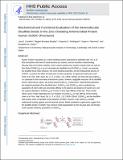Biochemical and Functional Evaluation of the Intramolecular Disulfide Bonds in the Zinc-Chelating Antimicrobial Protein Human S100A7 (Psoriasin)
Author(s)
Cunden, Lisa Stephanie; Brophy, Megan Brunjes; Rodriguez, Grayson E.; Flaxman, Hope A.; Nolan, Elizabeth Marie
DownloadAccepted version (1.860Mb)
Terms of use
Metadata
Show full item recordAbstract
Human S100A7 (psoriasin) is a metal-chelating protein expressed by epithelial cells. It is a 22-kDa homodimer with two EF-hand domains per subunit and two transition-metal-binding His[subscript 3]Asp sites at the dimer interface. Each subunit contains two cysteine residues that can exist as free thiols (S100A7[subscript red]) or as an intramolecular disulfide bond (S100A7[subscript ox]). Herein, we examine the disulfide bond redox behavior, the Zn(II) binding properties, and the antibacterial activity of S100A7, as well as the effect of Ca(II) ions on these properties. In agreement with prior work [Hein, K. Z., et al. (2013) Proc. Natl. Acad. Sci. U. S. A. 112, 13039-13044], we show that apo S100A7ox is a substrate for the mammalian thioredoxin system; however, negligible reduction of the disulfide bond is observed for Ca(II)- and Zn(II)-bound S100A7[subscript ox]. Furthermore, metal binding depresses the midpoint potential of the disulfide bond. S100A7[subscript ox] and S100A7[subscript red] each coordinate 2 equiv of Zn(II) with subnanomolar affinity in the absence and presence of Ca(II) ions, and the cysteine thiolates in S100A7[subscript red] do not form a third high-affinity Zn(II) site. These results refute a prior model implicating the Cys thiolates of S100A7[subscript red] in high-affinity Zn(II) binding [Hein, K. Z., et al. (2013) Proc. Natl. Acad. Sci. U. S. A. 112, 13039-13044]. S100A7[subscript ox] and the disulfide-null variants show comparable Zn(II)-depletion profiles; however, only S100A7[subscript ox] exhibits antibacterial activity against select bacterial species. Metal substitution experiments suggest that the disulfide bonds in S100A7 may enhance metal sequestration by the His[subscript 3]Asp sites and thereby confer growth inhibitory properties to S100A7[subscript ox]. Keywords: disulfides; redox reactions; peptides and proteins; monomersIons
Date issued
2017-10Department
Massachusetts Institute of Technology. Department of ChemistryJournal
Biochemistry
Publisher
American Chemical Society (ACS)
Citation
Cunden, Lisa S. et al. "Biochemical and Functional Evaluation of the Intramolecular Disulfide Bonds in the Zinc-Chelating Antimicrobial Protein Human S100A7 (Psoriasin)." Biochemistry 56, 43 (October 2017): 5726-5738 © 2017 American Chemical Society
Version: Author's final manuscript
ISSN
0006-2960
1520-4995